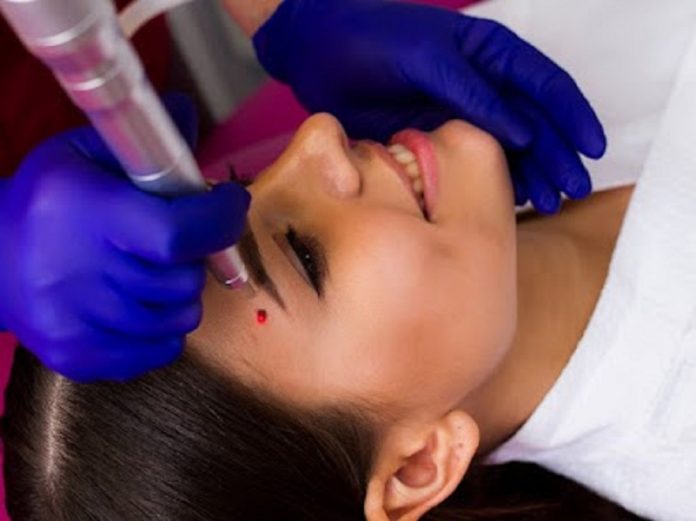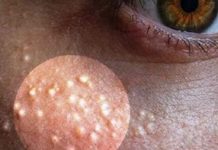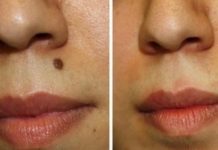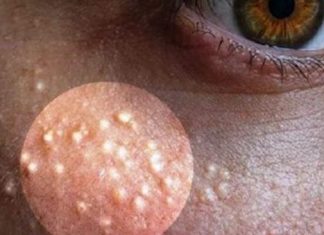There would hardly be anyone who doesn’t have a mole on their body. But how are they formed? Our skin is made up of cells called melanocytes. These cells are scattered throughout the skin, but when they accumulate together in form of clusters, it forms a mole. Moles are non-cancerous growth on the skin that vary widely in shape, size, and colour. Moles can appear bumpy above the surface of the skin or can be flat, can be smooth in texture or uneven, can vary in size, and be of any colour ranging from brown, pink, red, tan, or black. They are usually oval or round.
It is not unusual for people to have 10 to 40 moles on their bodies altogether, and often not medically concerning. Some moles, however, can be cancerous and turn into melanoma, a form of skin cancer, which can even be life-threatening if not treated promptly.
What Are the Different Types of Moles?
Moles can be categorised into three different types:
Congenital moles
As the name suggests, congenital moles are present from birth or appear during a baby’s first year. Congenital moles are a type of pigmented birthmark, and about 1 in 100 people are born with it. They vary in size and are more likely to develop into melanoma.
Common moles
This is the most commonly found mole type. They are also known as acquired moles because you get them after birth. It has a distinct edge, is small, and is oval or round in shape. They can be smooth or rough and sometimes may have hair coming out of them. Common moles are mostly harmless, but if you have more than 50 of them, you may be at a greater risk of getting melanoma.
Atypical moles
Atypical moles are also called dysplastic nevi. These types of moles are usually asymmetrical, have a diameter greater than 6 mm, form unusual shapes, and can have two or more colour shades. They have uneven colouration, mostly with a dark brown centre and lighter edges. Atypical moles are generally hereditary. People with dysplastic nevi are at a greater risk of getting malignant melanoma. Thus, any changes in the moles should be promptly conveyed to the dermatologist to ensure early diagnosis and treatment.
Why do I need mole removal?
Most people prefer mole removal for cosmetic reasons because they do not find the moles pleasing and feel conscious about their looks, especially if the moles are on the face. Sometimes, the mole is in a very uncomfortable position and comes in the way often, so people opt for its removal. These are the optional reasons for mole removal, but in some cases, removal of mole becomes a necessity and is recommended by doctors. This happens when the mole seems cancerous. It is then removed and sent for biopsy to look for malignancy. The signs in a mole that could indicate a possibility of melanoma are summarized below as ABCDEs of melanoma:
A: Asymmetric appearance of the mole, with one half of the mole having a different appearance than the other half.
B: Mole with irregular borders.
C: Different colours in the same mole.
D: Moles that have a diameter larger than 6 mm.
E: Malignant moles or melanoma tends to change their characteristics and perhaps grow over time.
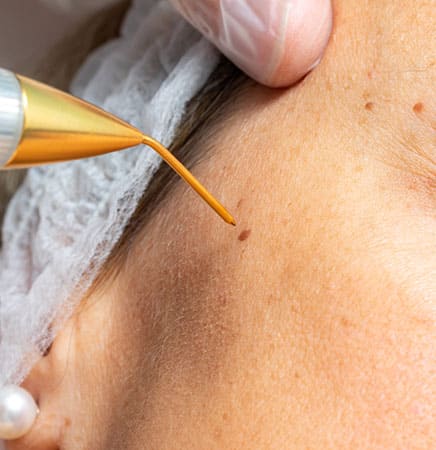
What are the different methods of mole removal?
There are a few different ways in which moles can be removed:
Laser mole removal
Laser mole removal is the modern and most convenient method of mole removal in Bolton and is trending around the world. An intense beam of light is focused on the mole during laser removal and burns it out. Following the procedure, a small red spot will remain at the previous mole site. A temporary dressing will be placed. A scab will form at that site in a few days, which will fall off, leaving behind a smooth pink spot that will fade away with time.
Shaving
This type of mole removal technique involves numbing the area around the mole with a local anesthetic and then using a scalpel to shave down the mole from the surface of the skin, such that just a smooth, pink mark remains.
Excision
This is the most traditional method of mole removal. A local anesthetic is used to numb the area surrounding the mole and the mole is cut out of the skin using surgical scissors or a scalpel. Some surrounding tissue may also be excised along with the mole. If the mole is deep-seated, excision might result in an open wound and may require stitches for closure. Excision is the preferred method of mole removal if there is any suspicion of cancer, and the specimen needs to be sent for biopsy.
Freezing
Superficial, non-malignant moles can be removed by the method of freezing. In this procedure, liquid nitrogen is used to freeze the mole which then drops off. A blister may form at the site due to a cold burn, which heals easily.
Fibroblasts
A plasma pen can also remove benign moles and skin tags successfully. The plasma pen is held above the skin and does not touch it during the procedure. The pen generates plasma energy that penetrates the skin’s outer layer causing the mole and skin tag to come off.
Perfection Cosmetic Laser & Aesthetic Clinic in Bolton, Manchester offers expert guidance and process consultation to all clients who are looking for permanent solutions to get rid of moles, warts, skin tags, and many other skin-related problems.
Why is Laser Removal of Mole Considered the Best Treatment Option?
The laser mole removal method indeed has several benefits over others. Following are a few to consider:
- It is a non-invasive procedure, so no cuts or wounds occur, and thus there is less risk of infection.
- Healing time is minimal, and most people are able to resume their daily activities almost immediately after mole removal treatment.
- Almost nil chances of scar formation.
- Multiple moles can be removed in a single sitting.
- The laser method is a very precise technique and no harm to adjacent tissue occurs.
- It is a very quick, painless, and convenient procedure.
What Kind of Moles Can Be Removed by Laser?
- Benign moles with no suspicion of cancer can be removed with a laser.
- The laser method cannot be used for moles requiring biopsy because no specimen can be obtained.
- Moles present in difficult-to-reach places such as the nose, ears, or certain areas of the face can also be easily removed by using the laser method.
Is Laser Mole Removal a Safe Method?
Yes, laser mole removal is a completely safe method, which is approved by CE. The eyes are covered during the procedure using protective goggles to avoid any harm to the eyes.
How Do I know if the Laser Mole Removal is Appropriate for Me?
Book a consultation at Perfection Cosmetic clinic in Bolton, our highly trained professionals will review your medical history and examine your moles to determine if laser treatment would be an appropriate mole removal technique for you. Do not make the decision yourself. A specialist is always the best person to guide you correctly.
Can I Remove My Moles Using Home Remedies?
You can get several tips and tricks on mole removal using home remedies online, but it is never recommended to remove the moles yourself at home. You can end up doing more harm than good and get cuts or wounds which can get infected and leave ugly scars. Similarly, over-the-counter mole-removing creams can cause an allergic reaction.
It is always admissible to get your moles removed by a professional as they will do it safely and completely. Consult the professionals at our laser clinic in Bolton, where we will assess the mole for any suspicion of cancer and guide you if any further treatment is needed.
Do the Moles Come Back After Removal?
In a small percentage of cases, the moles can recur after removal. This usually happens when some of the mole cells are left behind or not treated accurately during the procedure. You should go back to your clinic for a top-up if your mole returns. Additionally, protecting yourself from the harmful UV rays of the sun by wearing gloves, a hat, and sunscreen also decreases the likelihood of mole formation and recurrence.
What Precautions Should I Take After Laser Mole Removal?
No extensive precautions are required after laser mole removal. Just make sure that you do not pick at the mole site and do apply sunscreen regularly.
Why Book Mole Removal at Perfection Cosmetic?
Book mole removal with Great Manchester’s leading laser clinic, Perfection Cosmetic, where we focus on you, just not your looks! Perfection Cosmetics keeps up to date with the latest technologies and training so that you always get the best treatment available.
Our clients are offered a one-to-one pre-treatment consultation with our expert laser specialists, who perform a thorough evaluation of the patient, including the medical history and consultation, and then suggest the best possible treatment option for you.
We provide customised solutions to every client. You will be explained in detail about the procedure, expected outcomes, recovery time, possible risks, and cost, so that you can make an informed decision.
We, at Perfection Cosmetics, Bolton, feel honoured to be bestowed upon awards for its exemplary services, and we promise to continue with the same zeal.
Perfection Cosmetics has a long list of happy clients, and we would love to serve you as well. Fill out our contact form and BOOK a FREE no-commitment telephonic consultation with our clinic.
FAQs
How much does laser mole removal cost?
Laser mole removal starts from £100. Call on 01204 405114 to enquire in detail.
Can laser hair removal cause moles?
No, laser hair removal does not result in the formation of new moles.
Does laser mole removal hurt?
Laser mole removal done at Perfection Cosmetics is bearable and is very quickly completed. You may receive an anesthetic before the laser mole removal procedure.
Does laser mole removal leave a scar?
The laser mole removal used at Perfection Cosmetics does not usually leave any permanent scarring however everyone’s skin varies therefore there is a possibility if the aftercare is not followed correctly.
Can a mole grow back after laser removal?
Protecting yourself from the sun by using gloves, a hat, and sunscreen can prevent the recurrence of moles and the formation of new ones. There is a small chance, however, that a removed mole can reoccur. It is therefore recommended to have follow-ups with your clinic at regular intervals so that any recurrence can be noticed early and addressed.
Can laser mole removal cause cancer?
No. In fact, laser mole removal could prevent you from getting skin cancer, if the mole happened to be cancerous or had the tendency to develop into melanoma in the future.
How does laser mole removal work?
In the process of laser mole removal, high-intensity bursts of light are focussed on the mole, which breaks down the cluster of melanin in the mole and burns it away, resulting in mole removal. It is a non-invasive technique and allows you to get back to your routine life immediately after the procedure.
Is laser mole removal safe?
The laser used for the mole removal procedure is completely safe. The procedure gets tested in the labs to check its safety profile and is only approved to be used in clinics if found to be safe enough by the regulatory authorities who approved the machine to have a CE certificate… Thus, you can undertake laser mole removal treatment without any concerns.
Is laser mole removal permanent?
Yes, laser treatment removes the moles permanently. Although, in a very small percentage of cases, the mole can grow back, especially due to extensive sun exposure. Laser mole removal is the quickest, safest, and painless procedure to get rid of those unsightly moles.
Is laser mole removal painful?
You will feel slight discomfort during the laser mole removal procedure… Your laser practitioner may apply an anesthetic at the site before commencing the procedure.
Is laser mole removal dangerous?
Laser mole removal is not a dangerous procedure. It is the safest among all methods of mole removal techniques because it is non-invasive and does not involve any cuts or stitches, thus there is no risk of infection or scarring with the laser mole removal method.
What to do after laser mole removal?
Immediately following laser mole removal, your practitioner may apply a small dressing on the treated area, which you can remove the next morning. Do not use makeup at the site until the scab has fallen off, which may take about 10 days. Remember to apply sunscreen to the treated area though.

